Arctic Ground Squirrels or Urocitellus parryii
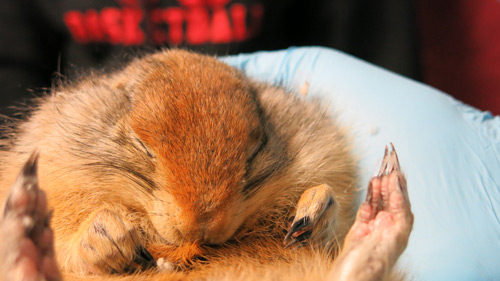 Arctic Ground Squirrel face. Photo by DJ Kast
Arctic Ground Squirrel face. Photo by DJ Kast
Today we had a PolarTREC field trip to the Museum of the North on the campus of the University of Alaska Fairbanks. We met Jeanette Moore, a researcher who studies Arctic Ground Squirrels, and she gave us a fascinating presentation all about the lovely squirrels.
Furthermore, the University of Alaska Fairbanks has a lab devoted to studying Arctic ground squirrels. Their lab includes a room with freezer like conditions which also comes with hibernating squirrels. Jeanette brought one of them in a cooler to the museum for us to see. All of the teachers were able to hold the squirrel but only after we put on gloves to protect it from our germs! They were so CUTE! The squirrel felt so furry and cold in my hands.
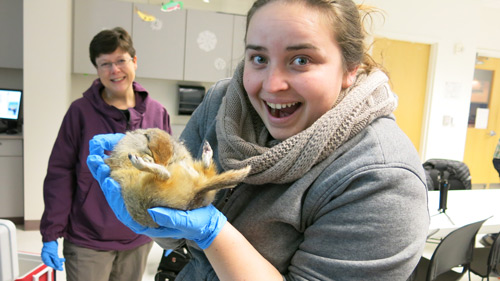 I am holding a hibernating Arctic Ground Squirrel in my hand!
I am holding a hibernating Arctic Ground Squirrel in my hand!
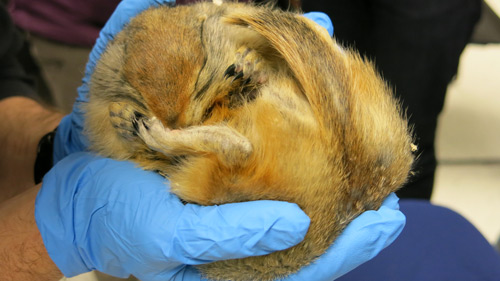 Arctic Ground Squirrel ball. Photo by DJ Kast
Arctic Ground Squirrel ball. Photo by DJ Kast
[VIDEO]
Information on Arctic Ground Squirrels
Physical Characteristics of Arctic Ground Squirrels
It had reddish fur on its face and front and white bespeckled grayish to brownish fur on its back. It had strong front paws with long black nails that are well adapted for digging and burrowing with pink feet pads.
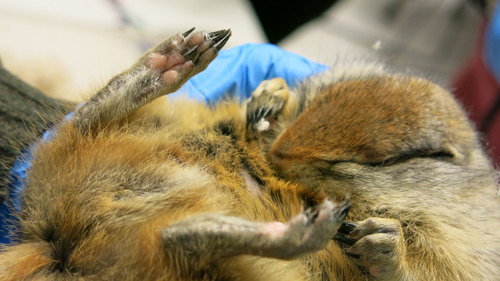 Arctic Ground Squirrel side view. Photo by DJ Kast
Arctic Ground Squirrel side view. Photo by DJ Kast
Habitat
The Arctic Ground Squirrels live in the Arctic! Who would have guessed? They live specifically in the Arctic Tundra and this research project that Jeanette Moore does is based out of Toolik Field Station which is where I am going! Apparently I will be seeing them in the WILD!
 Arctic Ground Squirrel ball. Photo by DJ Kast
Arctic Ground Squirrel ball. Photo by DJ Kast
Life Span
3-5 years for males life span 7-8 years female life span Oldest Jeannette has seen was 12 years old and it was a reproductively active female.
Yearly Life Cycle of a Arctic Ground Squirrel
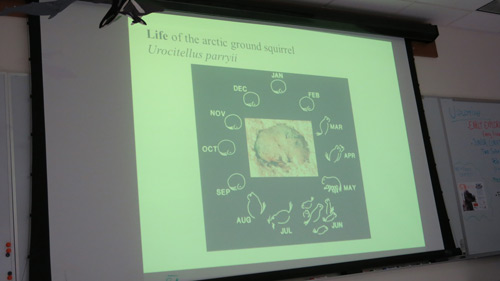 Life Cycle of Arctic Ground Squirrel. Slide by Jeannette Moore, photo by DJ Kast
Life Cycle of Arctic Ground Squirrel. Slide by Jeannette Moore, photo by DJ Kast
Hibernation
During hibernation, Arctic Ground Squirrels lower their metabolic rate, lower their body temperature to (-2C), slow their breathing (1-3 shallow breaths per minute), slow heart rate (1 beat per minute), decrease their blood pressure, lower blood supply to the brain (2% of normal), and there is no brain activity. They turn off their circadian clock during hibernation. Apparently, the squirrel has a lot of fat globules in their blood when it hibernates. Jeannette mentioned trying to take blood samples during hibernation modes and the syringe being almost white colored because of all the fat. She said that glycoproteins instead of glucose for metabolism.
Temperature Data during Hibernation
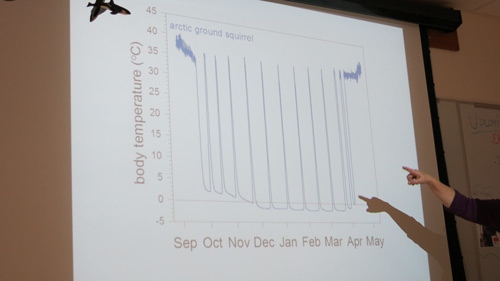 Arctic Ground Squirrel Data-Slide by Jeannette Moore, photo by DJ Kast
Arctic Ground Squirrel Data-Slide by Jeannette Moore, photo by DJ Kast
Jeannette Moore's project included having a temperature sensor called an i-button inside the Arctic Ground Squirrels and these sensors take temperature readings once every 4 hours for 2 years for each of the 300 squirrels in their study.
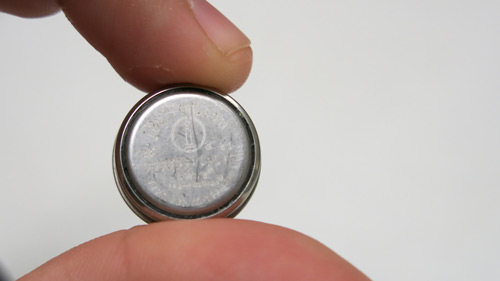 This is an I-button- an instrument that can take temperature data inside a Arctic Ground Squirrel every 4 hours for 2 years. Photo by DJ Kast
This is an I-button- an instrument that can take temperature data inside a Arctic Ground Squirrel every 4 hours for 2 years. Photo by DJ Kast
This is an example of one of their squirrel's temperature data plotted over the course of a year. What patterns do you notice? Do you notice the seasons? Do you notice the waking up once a month? What's that all about?
Did you know? Interesting Reproductive Fact
Males have to go through puberty every year. Testes descend once a year after hibernation and they reascend before the winter hibernation.


Comments